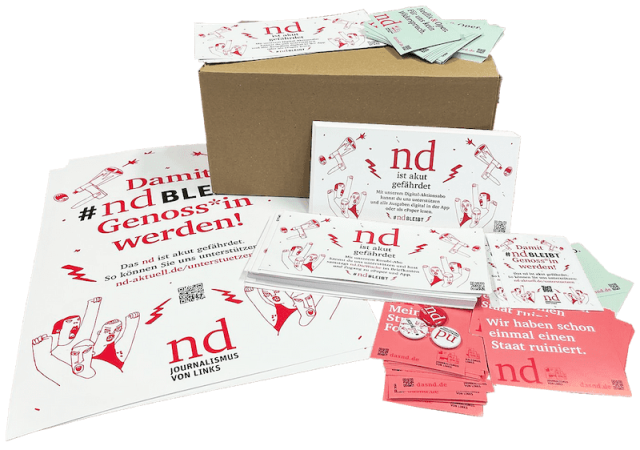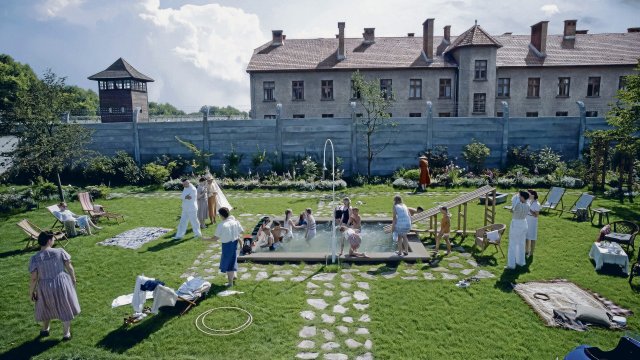Scene of family happiness in front of the wall at the Auschwitz concentration camp and extermination camp in the film “The Zone of Interest”
Foto: imago/Landmark Media
Jonathan Glazer’s “The Zone of Interest” is about the intimate family life of concentration camp commander Rudolf Höß close to the wall of the Auschwitz concentration and extermination camp. The overlay of private idyll and cold destruction made the audience shudder and cheer at the same time. The newspaper “Welt” wrote about “perhaps the best Holocaust film ever made,” and even in the extreme right-wing “Secession” there were predominantly words of praise. The audience cannot help but develop sheer disgust for the bourgeois life in the immediate vicinity of industrial mass murder, even though this is not visually depicted in any second of the film. Is this even about the Shoah?
Representation of the unrepresentable
The question of whether the Shoah can be represented has accompanied the “Holocaust film” since its beginnings. For the sociologist and film theorist Siegfried Kracauer, looking at the “heap of tortured human bodies in films about concentration camps” was a way to “release the horror from its invisibility behind the veils of panic and fantasy” and to make it combatable. Herbert Marcuse, on the other hand, saw the danger in the realistic representation of its incorporation into common viewing habits, into the tangible. Because if the special feature of the Shoah is the overwhelming of the comprehensible, its visualization must also be abstracted and broken.
Many films have attempted to portray the unrepresentable and, in turn, have produced an iconization of now well-known characters. The trained audience is familiar with the close-up of shower heads, the peephole, the screaming behind the locked steel door, with mountains of glasses, hair, suitcases and shoes. What is suggested gains its meaning precisely through what is omitted and absent. Claude Lanzmann’s nine-hour documentary “Shoah” from 1985 completely foregoes the filmic representation of the Shoah; after all, no play, no imitation, no image is able to show what needs to be shown.
»The Zone of Interest« makes extensive use of the rich repertoire of familiar references: smoke, screams, the sounds of gunshots, chimneys, walls. Indexical symbols, i.e. symbols with a cause-and-effect relationship, work well for their intended purpose. Smoke is the result of fire, a loud bang is the result of a gunshot. Throughout the film, the audience is confronted – indirectly, but with a sledgehammer, so to speak – about the destruction of life behind the wall. If he finds himself blocking out the background scenery even for a moment, he feels close to a realization. The realization of the inhumanity of everyday life, while horror rages next door.
nd.DieWoche – our weekly newsletter

With our weekly newsletter nd.DieWoche look at the most important topics of the week and read them Highlights our Saturday edition on Friday. Get your free subscription here.
What is evil?
It is not without reason that “The Zone of Interest” is associated with Hannah Arendt’s dictum about the banality of evil, whose prototype Rudolf Höß appears in the film. Höß is portrayed as a classic desk worker – obedient, reliable, dutiful, hard-working, tidy; At the same time, he loves children, loves animals and loves nature. Rudolf Höß worked on this depiction in his autobiographical notes “My Psyche. “Being, Living and Experiencing” was still actively involved during his lifetime. His attempt to create a conscientious but at the same time complex character, whose psyche would be worth investigating, is doubly ideological: firstly, because his self-perception suppresses the “unreasonable”, delusional motives and replaces them with justifications that are understood to be innocent – in psychology one speaks of (private) rationalization. In addition, his mental life as that of an individual is not worth examining, only as an example of the Nazi psyche.
The development of a way of thinking that is thoroughly socially functional undoubtedly laid the foundation for the character that made Auschwitz possible. It is no coincidence, as Theodor W. Adorno wrote, that the “mentally crippled” reach the top of the totalitarian hierarchies because their psychology, characterized by ego weakness, “is exactly in harmony with the irrationality of the ends.” The correction of the psyche in modern times is a necessary condition, but not the sufficient justification for the collapse of civilization in Auschwitz, as the example of Höß shows best.
Höß joined the NSDAP in 1922, long before it was supposedly opportune. He was enthusiastic about National Socialist writings by Hitler, Goebbels and Rosenberg and derived from them the necessity of the absolute extermination of the Jews. In 1923, Höß took part in the murder of a person he believed to be a communist, and after his subsequent prison sentence he joined the radical ethnic settler association Artamanen. The criticism that has often been raised against Arendt’s “Banality of Evil” – that the image of the desk worker who obeys authority obscures the fanaticism and anti-Semitism that is ready to destroy – can also be transferred to Höß and “The Zone of Interest”.
The management of Auschwitz was not a job like any other, because its purpose – extermination for the sake of extermination – must be viewed as counter-rational, not just irrational. No modern culture and society had previously turned away from all reality, morality and practical rationality. On a psychological level, pathology became normal, destructiveness became a personality structure that conformed to society.
The audience perceives Höß’s middle-class family life in “The Zone of Interest” as normal, but can accurately see through his normality as pathological. However, it remains unclear what exactly constitutes this pathology. In short, director Glazer confronts the audience with banality, not evil. If the commander of the Auschwitz concentration camp was merely an executive human shell, then who actually gave the orders?
Human coldness
Evil becomes a force of nature in “The Zone of Interest”; especially the evil in people. A few days after Glazer’s acceptance speech at the Oscars – the film was not produced to “confront us with what was done back then, but with what is happening today” – Piotr Cywiński, director of the Auschwitz Memorial, wrote benevolently on the Platform X, “The Zone of Interest” is not a film about the Shoah, but primarily a profound warning about humanity and its nature. If, from a materialist perspective, one shudders in any case when “human nature” is invoked, a devastating statement can be derived from Cywiński’s comment: inhumanity is human nature. Auschwitz was human nature.
In the last third of the film, Rudolf’s wife Hedwig’s mother unexpectedly leaves. Hedwig becomes angry and directs her aggression against the housemaid who happened to be present: “If I wanted, my husband would immediately scatter your ashes over the fields of Babice.” In this brief outburst of hostility, it is not evil in the form of fanatical Nazism that shines through Hedwig’s personal insult. “The Zone of Interest” lets the audience believe that they have discovered the core of National Socialism: no ideology at all, but a lot of cold-heartedness.
Only through the simultaneous omissions – of Nazi ideology, the collapse of civilization and the depiction of extermination – is Auschwitz removed from its specificity and context and thus normalized. “The Zone of Interest” is not about Auschwitz, but about the “Auschwitz Principle.” For Arendt and her legacy today, the concentration camp is seen as a necessary culmination of modern social administration, as a mere result of bureaucracy and human coldness, not as a result of authoritarian pseudo-rebellion and anti-Semitic madness that is both modern and anti-modern.
»The Zone of Interest« formulates an abstract criticism of order, discipline, sobriety and power without making the incomprehensible of the Shoah tangible. Couldn’t the wall that separates Höß’s garden from the concentration camp also be the wall between Israel and Palestine and aren’t all Israelis a bit like the Höß family, as Glazer himself suggested? “The Zone of Interest” would have nothing to respond to such historical revisionism. Designating the wall of the Auschwitz concentration camp as a symbol of a wall can only be done by those who do not care about the reason for its construction.
Timon Wißfeld is a communication designer and deals with the design of memory and commemoration.
#ndstays – Get active and order a promotional package

Regardless of whether it is pubs, cafés, festivals or other meeting places – we want to become more visible and reach everyone who values independent journalism with an attitude. We have put together a campaign package with stickers, flyers, posters and buttons that you can use to get active and support your newspaper.
To the promotional package
sbobet link sbobet sbobet88 link sbobet
